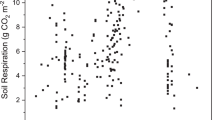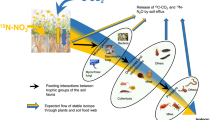Abstract
Peatlands store one-third of global soil carbon1. Drought/drainage coupled with climate warming present the main threat to these stores1,2,3,4. Hence, understanding drought effects and inherent feedbacks related to peat decomposition has been a primary global challenge5,6. However, widely divergent results concerning drought in recent studies3,7,8,9,10,11 challenge the accepted paradigm that waterlogging and associated anoxia are the overarching controls locking up carbon stored in peat. Here, by linking field and microcosm experiments, we show how previously unrecognized mechanisms regulate the build-up of phenolics, which protects stored carbon directly by reducing phenol oxidase activity during short-term drought and, indirectly, through a shift from low-phenolic Sphagnum/herbs to high-phenolic shrubs after long-term moderate drought. We demonstrate that shrub expansion induced by drought/warming2,6,10,12,13 in boreal peatlands might be a long-term self-adaptive mechanism not only increasing carbon sequestration but also potentially protecting historic soil carbon. We therefore propose that the projected ‘positive feedback loop’ between carbon emission and drought in peatlands2,3,14,15 may not occur in the long term.
This is a preview of subscription content, access via your institution
Access options
Subscribe to this journal
Receive 12 print issues and online access
$209.00 per year
only $17.42 per issue
Buy this article
- Purchase on Springer Link
- Instant access to full article PDF
Prices may be subject to local taxes which are calculated during checkout




Similar content being viewed by others
References
Joosten, H. The Global Peatland CO2 Picture. Peatland Status and Drainage Related Emissions in All Countries of The World (Ede, 2010).
Bragazza, L., Parisod, J., Buttler, A. & Bardgett, R. D. Biogeochemical plant–soil microbe feedback in response to climate warming in peatlands. Nature Clim. Change 3, 273–277 (2012).
Fenner, N. & Freeman, C. Drought-induced carbon loss in peatlands. Nature Geosci. 4, 895–900 (2011).
Dorrepaal, E. et al. Carbon respiration from subsurface peat accelerated by climate warming in the subarctic. Nature 460, 616–619 (2009).
Belyea, L. R. & Baird, A. J. Beyond “the limits to peat bog growth”: Cross-scale feedback in peatland development. Ecol. Monogr. 76, 299–322 (2006).
Dise, N. Environmental science. Peatland response to global change. Science 326, 810–811 (2009).
Carter, M. S. et al. Synthesizing greenhouse gas fluxes across nine European peatlands and shrublands—responses to climatic and environmental changes. Biogeosciences 9, 3739–3755 (2012).
Muhr, J., Hoehle, J., Otieno, D. O. & Borken, W. Manipulative lowering of the water table during summer does not affect CO2 emissions and uptake in a fen in Germany. Ecol. Appl. 21, 391–401 (2011).
Turetsky, M. R., Donahue, W. F. & Benscoter, B. W. Experimental drying intensifies burning and carbon losses in a northern peatland. Nature Commun. 2, 514 (2011).
Laiho, R. Decomposition in peatlands: Reconciling seemingly contrasting results on the impacts of lowered water levels. Soil Biol. Biochem. 38, 2011–2024 (2006).
Noormets, A. et al. Response of carbon fluxes to drought in a coastal plain loblolly pine forest. Glob. Change Biol. 16, 272–287 (2010).
Laiho, R., Vasander, H., Penttilä, T. & Laine, J. Dynamics of plant-mediated organic matter and nutrient cycling following water-level drawdown in boreal peatlands. Glob. Biogeochem. Cycles 17, 1053 (2003).
Elmendorf, S. C. et al. Plot-scale evidence of tundra vegetation change and links to recent summer warming. Nature Clim. Change 2, 453–457 (2012).
Ise, T., Dunn, A. L., Wofsy, S. C. & Moorcroft, P. R. High sensitivity of peat decomposition to climate change through water-table feedback. Nature Geosci. 1, 763–766 (2008).
Freeman, C., Ostle, N. & Kang, H. An enzymic ‘latch’ on a global carbon store—A shortage of oxygen locks up carbon in peatlands by restraining a single enzyme. Nature 409, 149 (2001).
Moore, S. et al. Deep instability of deforested tropical peatlands revealed by fluvial organic carbon fluxes. Nature 493, 660–663 (2013).
Makiranta, P. et al. Indirect regulation of heterotrophic peat soil respiration by water level via microbial community structure and temperature sensitivity. Soil Biol. Biochem. 41, 695–703 (2009).
Rousk, J., Smith, A. & Jones, D. Investigating the long-term legacy of drought and warming on the soil microbial community across five European shrubland ecosystems. Glob. Change Biol. 19, 3872–3884 (2013).
Oechel, W. C. et al. Acclimation of ecosystem CO2 exchange in the Alaskan Arctic in response to decadal climate warming. Nature 406, 978–981 (2000).
Richardson, C. J. in Wetland Habitats of North America (eds Baldwin, D. P. & Batzer, A. H.) 189–202 (Univ. California Press, 2012).
Bakker, S. A., Jasperse, C. & Verhoeven, J. T. A. Accumulation rates of organic matter associated with different successional stages from open water to carr forest in former turbaries. Plant Ecol. 129, 113–120 (1997).
Toberman, H. et al. Long-term drainage for forestry inhibits extracellular phenol oxidase activity in Finnish boreal mire peat. Eur. J. Soil Sci. 61, 950–957 (2010).
Toberman, H. et al. Summer drought effects upon soil and litter extracellular phenol oxidase activity and soluble carbon release in an upland Calluna heathland. Soil Biol. Biochem. 40, 1519–1932 (2008).
Turetsky, M. R., Crow, S. E., Evans, R. J., Vitt, D. H. & Wieder, R. K. Trade-offs in resource allocation among moss species control decomposition in boreal peatlands. J. Ecol. 96, 1297–1305 (2008).
Reiche, M., Hadrich, A., Lischeid, G. & Kusel, K. Impact of manipulated drought and heavy rainfall events on peat mineralization processes and source-sink functions of an acidic fen. J. Geophys. Res. 114, G02021 (2009).
McClymont, E. L. et al. Pyrolysis GC-MS as a rapid screening tool for determination of peat-forming plant composition in cores from ombrotrophic peat. Org. Geochem. 42, 1420–1435 (2011).
Ward, S. et al. Warming effects on greenhouse gas fluxes in peatlands are modulated by vegetation composition. Ecol. Lett. 20, 1285–1293 (2013).
Bragazza, L. et al. Atmospheric nitrogen deposition promotes carbon loss from peat bogs. Proc. Natl Acad. Sci. USA 103, 19386–19389 (2006).
Bragazza, L. & Freeman, C. High nitrogen availability reduces polyphenol content in Sphagnum peat. Sci. Total Environ. 377, 439–443 (2007).
Freeman, C., Fenner, N. & Shirsat, A. H. Peatland geoengineering: An alternative approach to terrestrial carbon sequestration. Phil. Trans. R. Soc. A 370, 4404–4421 (2012).
Acknowledgements
We would like to thank W. Willis and J. Bills for the field and laboratory measurement, R. Neighbarger for technical editing, N. Flanagan for providing water level data and T. Moore at McGill University for collection of Mer Bleue Sphagnum peat. Thanks also go to S. Ward and D. Kitts, USFWS, for helping with site selections and field assistance. Coastal Carolina/Southeastern Virginia Strategic Habitat Conservation Team, US Fish and Wildlife Service-Region 4, The Nature Conservancy of North Carolina, US DOE Office of Science, Terrestrial Ecosystem Sciences, under grant award DE-SC0012272 and the Duke University Wetland Center Endowment provided financial support.
Author information
Authors and Affiliations
Contributions
H.W. and C.J.R. designed the study, H.W. and M.H. conducted the research, H.W. analysed the data and wrote the manuscript with C.J.R., and all authors discussed results and commented on the manuscript.
Corresponding authors
Ethics declarations
Competing interests
The authors declare no competing financial interests.
Supplementary information
Rights and permissions
About this article
Cite this article
Wang, H., Richardson, C. & Ho, M. Dual controls on carbon loss during drought in peatlands. Nature Clim Change 5, 584–587 (2015). https://doi.org/10.1038/nclimate2643
Received:
Accepted:
Published:
Issue Date:
DOI: https://doi.org/10.1038/nclimate2643
This article is cited by
-
Changes in organic matter properties and carbon chemical stability in surface soils associated with changing vegetation communities in permafrost peatlands
Biogeochemistry (2023)
-
Long-Term Phosphorus Addition Strongly Weakens the Carbon Sink Function of a Temperate Peatland
Ecosystems (2023)
-
Hydrologic Restoration Decreases Greenhouse Gas Emissions from Shrub Bog Peatlands in Southeastern US
Wetlands (2022)
-
Vegetation and microbes interact to preserve carbon in many wooded peatlands
Communications Earth & Environment (2021)
-
The Effects of Hydrological Management on Methane Emissions from Southeastern Shrub Bogs of the USA
Wetlands (2021)



